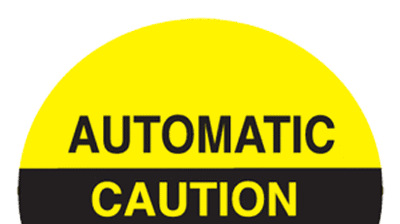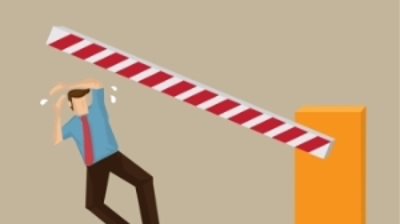AUTOMATIC GATE OPERATORS

The Relevance of UL 325 Standards
Download PDF of this article here
BY MICHAEL PANISH
DOOR & GATE EXPERT WITNESS
I was recently retained, just a week prior to expert disclosure, to replace another expert for a sliding gate injury claim. I was asked to visit and review the site and comment on the report authored by the opposing party’s expert which had been generated for a motion for summary judgement that was not granted. The site had remained unchanged since a crush injury occurred and the expert for the defense had authored a ludicrous report that needed to have facts verified and investigated for accuracy.
In the opposing expert report, he made claims that the automated gate operator was working per the manufacturers requirements, the amount of force that was observed was correct, and part of the operating characteristics and all of the necessary safety devices were present. From my site visit, I was able to observe that the gate was closing with almost 6 times the acceptable speed and force and had no safety devices functioning or installed. The inherent safety devices were non-functional, and although there was a pedestrian gate, it had been locked and was actually welded shut so no pedestrian could ever use it.
Per UL 325 (Underwriters Laboratories), when a gate operator is controlled by an instantaneous push button (meaning that a single push of the button starts or stops the gate operator), there is a requirement that at least two independent safety devices be part of the operating equipment and they must work in both directions of travel (opening and closing). In this claim, the operating push buttons were in an enclosed room without any view of the gate path of travel. They were instantaneous push button controls, so once pushed the gate would move without any safety features to control the movement of the gate travel.
For a horizontal sliding gate, UL entrapment protection is described under four categories:
- Type A is known as inherent entrapment (built in devices attached to the internal mechanism of the gate operator).
- Type B-1 pertains to non-contact sensors (for example - optical beams, infrared or microwave sensors) and Type B-2 describes contact sensors (for example - leading edge or other tactile compression sensing devices).
- Type C relates to inherent force limiting (for example - internal speed controls or clutch devices).
- Type D has to do with the activating devices (for example - the position, type and location of push buttons, card swipes, keypads).
There are associated UL listing categories that describe these requirements and provide information on the basic operating functions pertaining to each of the above categories. Most of the basic ideas for UL entrapment protection came into existence around 1995. By the year 2000, it was an industrywide accepted understanding that all gates required various entrapment protections features and most manufacturers provided equipment and designs to meet the standards.
The most basic reason that these entrapment systems exist is to avoid injuries to people and property. One essential layout requirement for vehicular gate systems is to provide a dedicated pedestrian path of travel, away from, and separate from any automatic gate system. If you choose to research correct installation design, you will find that no matter what type of gate or parking control arm is installed, a dedicated pedestrian path of travel must be part of an installation to be considered UL 325 compliant.
There are four divisions that address the class of a gate installation. Ranging from small residential installations in a home to large high security systems. Different products are needed to make these installations UL 325 compliant.
For example: When there is an attended guard shack adjacent to the vehicular gate, and the guard has complete control of the switch that operates the gate operator, there are conditions and situations when some of the safety equipment needed to protect both vehicles and pedestrians may be omitted. In that specific class of installation, the guard has to have an unobstructed full view of the path of travel of the gate at all times, whether opening or closing. If gate operation is left solely to the automatic gate operator device, then at least two anti-entrapment safety devices are required to be compliant.
In many cases, pedestrians are not only struck by a moving gate, they have suffered foot and toe amputations when run over by unhoused lower wheels, or have become crushed or had other body parts amputated between the edge of the gate and the point where it fully closes. There are numerous safety devices that can protect against such entrapment. If required safety devices are not installed, improperly maintained, or intentionally bypassed, people can become severely injured or even die from the force of the gate pushing upon them.
Many automatic gate operators rely upon electronic voltage spikes to cause the operator to stop and or reverse direction when an obstruction is encountered. Some operators use sacrificial chain links that break when an obstruction occurs, and the closing resistance passes a pre-determined force/pressure threshold. One requirement is that after sensing an obstruction, the gate operator must react within 2 seconds to stop or reverse away from that obstruction.
The UL 325 standards have very specific categories that discuss all of the above conditions in detail. There are trade organizations that incorporate and promote the UL standards for safe gate operator design and installation. As with all machines, appropriate maintenance and observation is required to provide safety for all users.
Mike Panish is a nationally recognized expert that is retained evenly for plaintiff and defense legal claims. He is currently the retained gate expert witness on numerous gate personal injury and wrongful death claims across the United States. He is extremely knowledgeable of the required standards and installation parameters that affect gate safety. He is routinely called upon by major product manufacturers to analyze injury claims from an independent and unbiased perspective. He is well known, highly respected, and is established as the industry expert of choice. He has provided his services for wrongful death, personal injury, and property damage claims and he has authored numerous articles pertaining to automatic gate safety and related injuries including gate operation and automated gate parking control arm systems. For a complete list of all of his expert services, areas of expertise, and published articles visit his website at www.constructionwitness.com. For additional information or to discuss your specific case needs, contact Mr. Panish’s office at (888) 902-4272 (Sharon), www.ConstructionWitness.com.



